What Are the Environmental Regulations for EVs?
As electric vehicles (EVs) rise as a sustainable alternative to traditional combustion engines, understanding the environmental regulations surrounding them becomes essential.
This overview highlights the regulations governing EVs, focusing on their role in reducing carbon emissions and air pollution. It also emphasizes their pivotal contribution to combating climate change.
You will explore the challenges encountered in implementing these regulations and examine both current and future frameworks internationally and nationally that shape the EV landscape.
Engage with these crucial topics as you gain insights into the future of environmentally friendly transportation.
Contents
- Key Takeaways:
- Overview of Environmental Regulations for EVs
- Benefits of EVs for the Environment
- Challenges in Implementing Environmental Regulations for EVs
- Current and Future Environmental Regulations for EVs
- Frequently Asked Questions
- What Are the Environmental Regulations for EVs?
- Why Are There Environmental Regulations for EVs?
- What Are Some Common Environmental Regulations for EVs?
- Do All Countries Have Environmental Regulations for EVs?
- How Do Environmental Regulations for EVs Benefit the Environment?
- Are There Any Challenges Associated With Implementing Environmental Regulations for EVs?
Key Takeaways:

- EVs play a crucial role in reducing carbon emissions, decreasing air pollution, and combating climate change.
- The implementation of environmental regulations for EVs faces challenges such as infrastructure and cost concerns.
- International and national regulations for EVs are constantly evolving to promote sustainable transportation.
Overview of Environmental Regulations for EVs
The overview of Environmental Regulations for Electric Vehicles (EVs) under the Biden-Harris Administration emphasizes a commitment to enhancing air quality and tackling the climate crisis through strict pollution standards aimed at the automotive industry.
With support from the U.S. Environmental Protection Agency and leaders like EPA Administrator Michael S. Regan, these regulations are designed to speed up the transition to clean vehicles.
This bold approach tackles environmental challenges head-on while stimulating economic growth and creating American jobs in EV manufacturing and battery production.
Explanation of Regulations
The regulations for electric vehicles include various standards established by the Biden-Harris Administration, with the U.S. Environmental Protection Agency leading efforts to develop advanced vehicle standards. These are designed to reduce greenhouse gas emissions gases that trap heat in the atmosphere and enhance air quality.
In addition to these standards, regulations such as the Clean Air Act provide a complete set of rules for assessing and controlling vehicle emissions. This regulatory backdrop is vital, imposing strict pollution controls on the automotive industry while fostering innovation in clean vehicle technologies.
There’s an urgent need to tackle climate change and improve public health as transportation significantly contributes to harmful emissions. To support this initiative, various incentives and funding programs encourage the adoption of electric vehicles, paving the way for a cleaner, more sustainable future.
Benefits of EVs for the Environment
The benefits of electric vehicles (EVs) for the environment are numerous and compelling. By adopting EVs, you significantly reduce carbon emissions and help decrease air pollution both key steps in addressing the climate crisis.
This shift safeguards the planet and promotes better public health in communities long affected by fossil fuel pollution.
Reducing Carbon Emissions

Reducing carbon emissions by embracing electric vehicles (EVs) is crucial to combat climate change and meet ambitious emissions targets set by regulatory bodies.
By replacing gasoline and diesel engines with electric motors, you eliminate tailpipe emissions, dramatically reducing urban air pollution and its associated public health risks. When powered by renewable energy, these vehicles have significantly lower lifecycle emissions than traditional internal combustion engines.
Take California, for example: a case study shows that EV adoption could cut greenhouse gas emissions by up to 40% by 2030.
Experts agree that increasing the number of EVs on the road aligns with global efforts to limit temperature rises and paves the way for a sustainable future for everyone.
Act now to support this crucial shift towards cleaner vehicles and join the movement for a sustainable future!
Decreasing Air Pollution
Transitioning to electric vehicles (EVs) offers a remarkable advantage: significant air pollution reduction. This shift enhances air quality and promotes environmental justice, benefiting communities disproportionately affected by traditional vehicle emissions.
These vehicles operate without tailpipe emissions, effectively slashing harmful pollutants like nitrogen oxides gases that can harm lungs and particulate matter tiny particles that contribute to respiratory diseases. Research reveals that regions with higher EV adoption report a staggering 30% decrease in respiratory illnesses, illustrating a clear link between clean air and improved public health outcomes.
Urban residents emphasize this positive change; many have experienced fewer asthma attacks and health complications since electric fleets began rolling out. The ripple effect of improved air quality is unmistakable, leading to reduced healthcare costs and enhancing the overall quality of life for everyone.
Impact on Climate Change
The impact of electric vehicles on climate change is profound. Their widespread adoption marks a pivotal shift away from fossil fuels, steering us toward a sustainable future powered by renewable energy.
This transition slashes greenhouse gas emissions and boosts energy independence and security. By integrating electric vehicles with renewable sources like solar and wind, you unlock opportunities for a cleaner energy grid, reducing the carbon footprint of daily commutes.
Governments worldwide are rolling out policies and incentives, increasingly electrifying the transportation landscape. Public charging infrastructures are expanding, making it easier for you to embrace electric vehicle ownership.
This collective momentum fosters innovation in battery technology and creates jobs, reinforcing a global commitment to tackling climate change.
Challenges in Implementing Environmental Regulations for EVs
Implementing environmental regulations for electric vehicles (EVs) presents challenges related to infrastructure and cost barriers. The Biden-Harris Administration must address these issues to ensure a seamless and equitable transition toward a cleaner automotive industry.
Infrastructure and Cost Concerns

Infrastructure and cost concerns are crucial for successfully implementing environmental regulations for electric vehicles. Developing a reliable charging infrastructure is essential for enhancing consumer choices and facilitating the electrification of transportation.
Without adequate charging stations, you may hesitate to consider electric vehicles, viewing them as impractical for your lifestyle. This hesitation reflects current market trends; for instance, regions with robust charging networks, like California, enjoy higher electric vehicle adoption rates.
Various initiatives are actively addressing the infrastructure gap, including government-funded projects and partnerships with private companies aimed at building more charging stations in both urban and rural areas.
Innovative solutions, such as mobile apps to locate charging stations easily and the introduction of fast-charging technology, could alleviate concerns about upfront costs, paving the way for broader acceptance of electric vehicles.
Current and Future Environmental Regulations for EVs
Current and future environmental regulations for electric vehicles (EVs) encompass a wide array of international and national standards designed to elevate sustainability within the automotive sector.
As you navigate this landscape, anticipated changes reflect a steadfast dedication to reducing greenhouse gas emissions and enhancing air quality.
Embracing these regulations positions you at the forefront of innovation and aligns your efforts with the growing imperative for a cleaner, more sustainable future.
Consider supporting electric vehicle initiatives and engaging with local environmental policies!
International and National Regulations
International and national regulations surrounding electric vehicles (EVs) create a framework that enforces greenhouse gas emissions standards rules designed to limit harmful emissions from vehicles while promoting sustainable practices within the automotive industry.
Though both types of regulations aim to tackle environmental concerns, they vary a lot in their scope and execution. For example, international regulations typically emphasize global sustainability goals and encourage cooperation across borders. In contrast, national regulations often reflect local market conditions and government policies. This divergence can influence how you, as a manufacturer, develop your EV models, as meeting international compliance might demand additional resources.
Regulations by entities like the European Union can prompt countries to reassess their own compliance requirements to remain competitive in the ever-evolving automotive landscape.
Anticipated Changes and Updates
Get ready for stricter standards from the U.S. Environmental Protection Agency that will empower the automotive industry in its transition to cleaner technologies.
As the landscape shifts, you’ll find that stakeholders ranging from automakers to environmental advocates are bracing for significant implications on production processes, supply chains, and consumer adoption rates. Enhanced emissions targets could serve as a catalyst for innovation, urging companies to invest more heavily in battery technology and sustainable materials.
Industry leaders contend that these regulations may create competitive advantages for those who adapt quickly while broadening the availability of EV incentives designed to encourage public adoption. These forthcoming regulatory changes are set to reshape not only the automotive industry but also the broader market dynamics surrounding electric mobility.
Frequently Asked Questions

What Are the Environmental Regulations for EVs?
Environmental regulations for EVs refer to laws and policies that promote the use and production of electric vehicles while reducing the negative environmental impact of traditional gasoline and diesel vehicles.
Why Are There Environmental Regulations for EVs?
There are environmental regulations for EVs because traditional vehicles contribute significantly to air pollution and greenhouse gas emissions, negatively impacting human health and the environment.
What Are Some Common Environmental Regulations for EVs?
Common environmental regulations for EVs include emissions standards, fuel efficiency requirements, and incentives for the production and use of electric vehicles.
Do All Countries Have Environmental Regulations for EVs?
No, not all countries have environmental regulations for EVs. However, many countries are either implementing or considering these regulations to reduce their carbon footprint and promote sustainable transportation options.
How Do Environmental Regulations for EVs Benefit the Environment?
These regulations cut air pollution and greenhouse gases, helping combat climate change and improve overall air quality.
Are There Any Challenges Associated With Implementing Environmental Regulations for EVs?
Yes, challenges can arise when implementing environmental regulations for EVs, such as the costs of transitioning to electric vehicles and potential resistance from the automotive industry. However, the long-term benefits to the environment outweigh these challenges.
Stay informed and be ready to adapt to the future of electric mobility!






